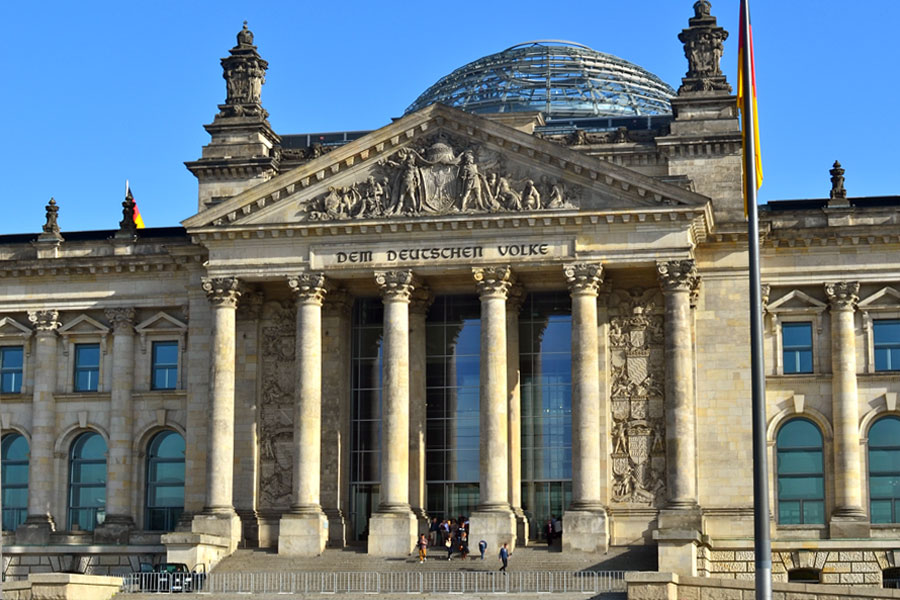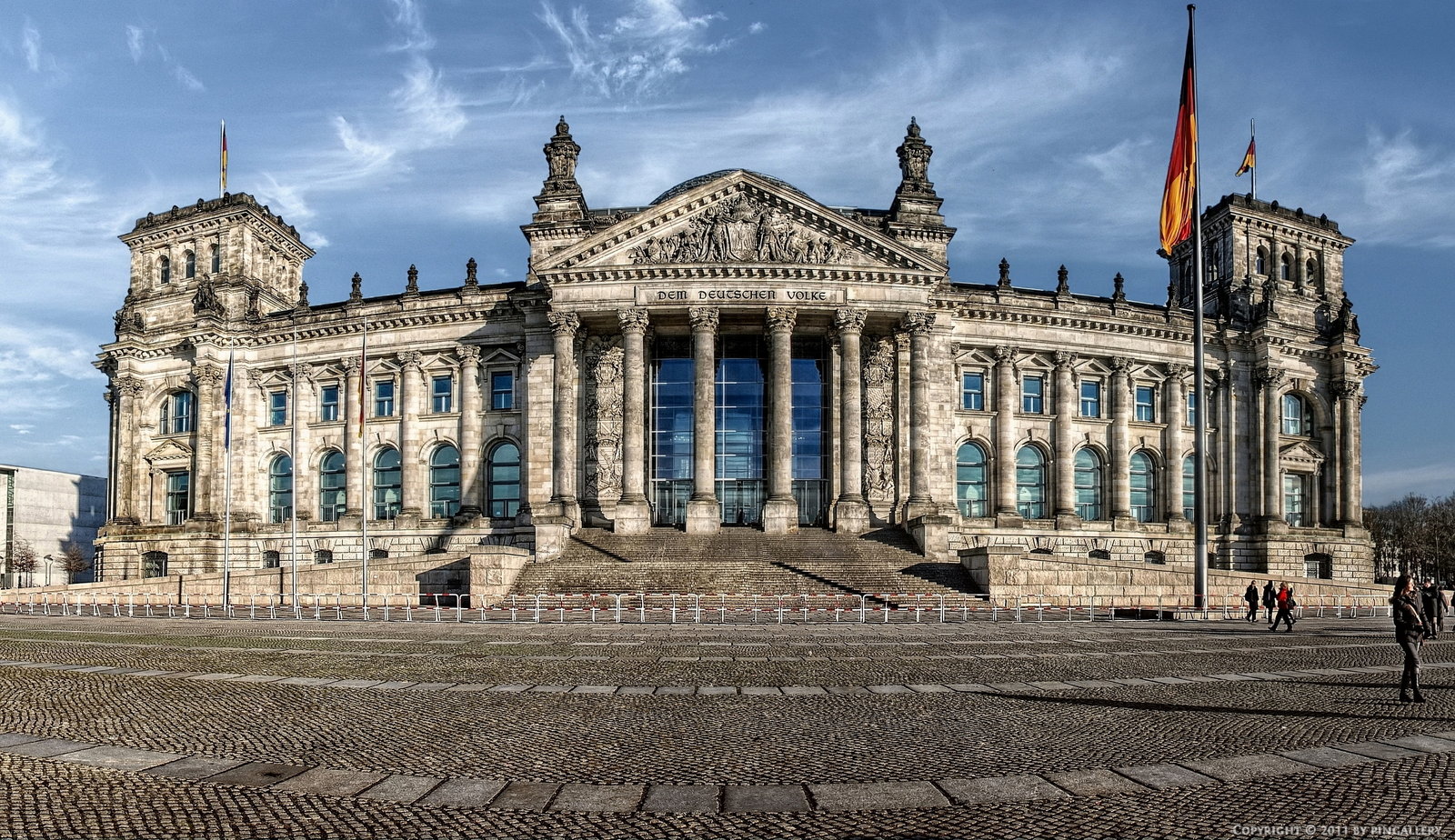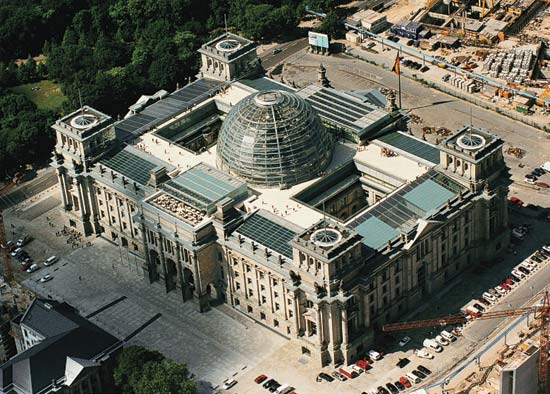The Reichstag building (German: Reichstagsgebäude; officially: Plenarbereich Reichstagsgebäude) is a historical edifice in Berlin, Germany, constructed to house the Imperial Diet (German: Reichstag), of the German Empire. It was opened in 1894 and housed the Diet until 1933, when it was severely damaged in a fire. After World War II, the building fell into disuse; the parliament of the German Democratic Republic (the Volkskammer) met in the Palast der Republik in East Berlin, while the parliament of the Federal Republic of Germany (the Bundestag) met in the Bundeshaus in Bonn.
The ruined building was made safe against the elements and partially refurbished in the 1960s, but no attempt at full restoration was made until after German reunification on 3 October 1990, when it underwent a reconstruction led by architect Norman Foster. After its completion in 1999, it once again became the meeting place of the German parliament: the modern Bundestag.
The term Reichstag, when used to connote a diet, dates back to the Holy Roman Empire. The building was built for the Diet of the German Empire, which was succeeded by the Reichstag of the Weimar Republic. The latter would become the Reichstag of Nazi Germany, which left the building (and ceased to act as a parliament) after the 1933 fire and never returned; the term Reichstag has not been used by German parliaments since World War II. In today's usage, the German word Reichstag (Imperial Diet Building) refers mainly to the building, while Bundestag (Federal Diet) refers to the institution.
History of the building
Construction of the building began well after the unification of Germany in 1871. Previously, the parliament had assembled in several other buildings in Leipziger Straße in Berlin but these were generally considered too small, so in 1872 an architectural contest with 103 participating architects was carried out to erect a new building. After a short survey of possible sites, a parliamentary committee recommended the east side of the Königsplatz (today, Platz der Republik), which however was occupied by the palace of a Polish-Prussian aristocrat, Athanasius Raczyński.
Work did not start until ten years later though, owing to various problems with purchasing the property and arguments between Wilhelm I, Otto von Bismarck, and the members of the Reichstag about how the construction should be performed. After lengthy negotiations, the Raczyński Palace was purchased and demolished, making way for the new building.
In 1882, another architectural contest was held, with 200 architects participating. This time the winner, the Frankfurt architect Paul Wallot, would actually see his Neo-Baroque project executed. The direct model for Wallot's design was Philadelphia's Memorial Hall, the main building of the 1876 Centennial Exhibition. The Reichstag's decorative sculptures, reliefs, and inscriptions were by sculptor Otto Lessing. On 29 June 1884, the foundation stone was finally laid by Wilhelm I, at the east side of the Königsplatz. Before construction was completed by Philipp Holzmann A.G. in 1894, Wilhelm I died (in 1888, the Year of Three Emperors). His eventual successor, Wilhelm II, took a more jaundiced view of parliamentary democracy than his grandfather. The original building was acclaimed for the construction of an original cupola of steel and glass, considered an engineering feat at the time. But its mixture of architectural styles drew widespread criticism.
In 1916 the iconic words Dem Deutschen Volke ("[To] the German people") were carved above the main façade of the building, much to the displeasure of Wilhelm II who had tried to block the adding of the inscription for its democratic significance. After World War I had ended and Wilhelm had abdicated, during the revolutionary days of 1918, Philipp Scheidemann proclaimed the institution of a republic from one of the balconies of the Reichstag building on 9 November. The building continued to be the seat of the parliament of the Weimar Republic (1919–1933), which was still called the Reichstag.
Reunification
The official German reunification ceremony on 3 October 1990, was held at the Reichstag building, including Chancellor Helmut Kohl, President Richard von Weizsäcker, former Chancellor Willy Brandt and many others. The event included huge firework displays[citation needed]. One day later, the parliament of the united Germany would assemble in an act of symbolism in the Reichstag building.
However, at that time, the role of Berlin had not yet been decided upon. Only after a fierce debate, considered by many as one of the most memorable sessions of parliament, did the Bundestag conclude, on 20 June 1991, with quite a slim majority in favour of both government and parliament returning to Berlin from Bonn.
In 1992, Norman Foster won yet another architectural contest for the reconstruction of the building. His winning concept looked very different from what was later executed. Notably, the original design did not include a cupola.
Before reconstruction began, the Reichstag was wrapped by the Bulgarian-American artist Christo and his wife Jeanne-Claude in 1995, attracting millions of visitors. The project was financed by the artists through the sale of preparatory drawings and collages, as well as early works of the 1950s and 1960s.
During the reconstruction, the building was first almost completely gutted, taking out everything except the outer walls, including all changes made by Baumgarten in the 1960s. Respect for the historic aspects of the building was one of the conditions stipulated to the architects, so traces of historical events were to be retained in a visible state. Among them were graffiti left by Soviet soldiers after the final battle for Berlin in April–May 1945. Written in Cyrillic script, they include such slogans as "Hitler kaputt" and names of individual soldiers. However, graffiti with racist or sexist themes were removed, in agreement with Russian diplomats at the time.
The reconstruction was completed in 1999, with the Bundestag convening there officially for the first time on 19 April of that year. The Reichstag is now the second most visited attraction in Germany, not least because of the huge glass dome that was erected on the roof as a gesture to the original 1894 cupola, giving an impressive view over the city, especially at night.














